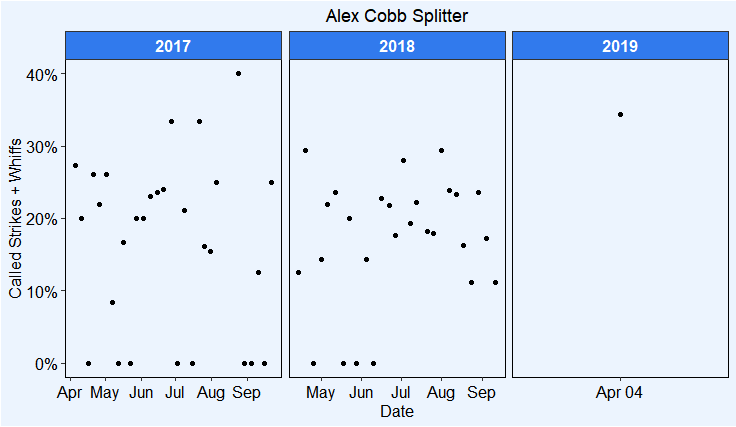Alex Cobb has not been fantasy relevant for a long time now. At the start of his career, he was pretty awesome, posting a 2.76 ERA, 3.36 FIP, 1.15 WHIP and 23.2% strikeout rate in 2013, and a 2.87 ERA, 3.23 FIP, 1.14 WHIP and 21.9% strikeout rate in 2014.
Then, he had Tommy John surgery and everything fell apart. He missed all of 2015 recovering, only pitched 22 innings in 2016 (and they were bad innings) and returned as a full-time starter in 2017 to the tune of an okay 3.66 ERA alongside a 4.16 FIP, 1.77 WHIP and 15.4% strikeout rate.
Last year was even worse. After signing with the Baltimore Orioles, Cobb regressed as his peripherals suggested he would and posted a miserable 4.90 ERA, 4.80 FIP, 1.41 WHIP, and 15.4% strikeout rate. There was absolutely nothing there for fantasy players.
So what happened to him? I dove into it before the start of last season, but basically here’s what happened: Cobb lost his split-change, a pitch he used to call “The Thing.” It was far and away his best pitch pre-surgery, posting a 21.2 pVAL, 53.1% chase rate and 18.8% SwStr rate in 2014.
Take a look at this filth:
It was a magical pitch, and all of a sudden he stopped using it once he had his surgery. In 2013, he threw the pitch 33.3% of the time, in 2014, 37.7% of the time. Once he was back starting in 2016, that dropped to just 14.4% of the time and increased slightly to 22.9% of the time last year.
The pitch itself didn’t change all that much, but what did change was where Cobb was releasing the pitch. When he did throw it, he was releasing it higher than he ever did before, and more importantly, higher than the rest of his pitches. As a result, hitters were less fooled by it.
It’s understandable that Cobb would struggle with his split-change—changeup struggles are common for players recovering from Tommy John, so I, like many others, just kind of gave up on the idea that The Thing would ever return and that Cobb would ever be effective again. And if you looked at the line from his first start of the year against the New York Yankees, you’d probably figure it was the same old Cobb—5.2 innings pitched, two earned runs, four strikeouts.
But that start gave me a glimmer of hope, because The Thing made an appearance. Actually it appeared a few times, and it was looking good:
“Now Ben,” you say, “it’s one game, he threw the splitter a few times. It looked pretty nice when he threw it last year, so why is this game any different than all the others last year?” I’m glad you asked.
Let’s start with how much he threw it, because that’s important. In that game, Cobb’s splitter comprised 36.8% of his total pitches, good for the sixth-highest percentage he’s had since the start of 2017.
And more importantly, the pitch was very effective, logging a 34.4% CSW, better than any single start Cobb had last year (save for one outlier start in 2017 where he threw the pitch five times and got two CSWs, which is technically a 40% CSW rate).
Here’s how that looks visually:

So Cobb’s splitter was more effective during his first start this year than it has been in the past two years. But why? Was it just a lucky day for him? That’s entirely possible, it is just one game after all, but there’s reason to believe that Cobb has made some noticeable changes to his game this year.
First of all, he’s only pitching from the stretch now, a decision he made in spring training to simplify his game.
“The simplicity of it seems like a good idea,” he said during spring training. “When you go home at night, when you’re practicing your bullpens, you’re always thinking about two different deliveries. I want to clean all those thoughts up and stop worrying about both.”
He added, “When you are younger, you don’t have the strength and you need that little extra momentum [from a windup]. But now, I’m the strongest I’ve been in my career. It’s a good time to try it and see how it feels. When the ball is jumping like it is, you’ve got everything you need. And also honestly, there were times I mixed up my timing on it. Almost slide step out of the stretch with no one on and it can throw off the timing of the hitter a little bit.”
So he’s simplifying his delivery to make it more repeatable (and potentially a bit more deceptive), something pitchers like Carlos Carrasco, Jake Arrieta and Chris Archer have all done. This is a good thing and it could make it easier for him to throw his splitter more consistently.
Also, remember how I said one of the main problems with Cobb’s splitter was that he changed his vertical release point? Well, that changed dramatically in his first start this year:

That vertical release point dropped way on down, back to where it used to be in 2014, when his splitter was significantly more effective. I can’t help but think that Cobb’s change in his delivery and his lowered vertical release point are related.
So, what’s the takeaway from all of this? Should you go run and grab Alex Cobb in all of your fantasy leagues? No, it’s just one start and this could all easily blow up. However, I think this is something you should pay attention to. There seems to be something going on here—a definitive skill change that Cobb has made—and if he keeps up with it, keeps that vertical release down and keeps throwing his splitter more, he could go back to being an effective pitcher.
If we see another couple starts where his splitter use and effectiveness are similar or better than his first, I’m going to start picking him up in my leagues, and you should too.
Photo by Frank Jansky/Icon Sportswire.


Nice analysis. And the O’s could certainly use some good news!
Thanks! And I know right? It’s been a long season already haha